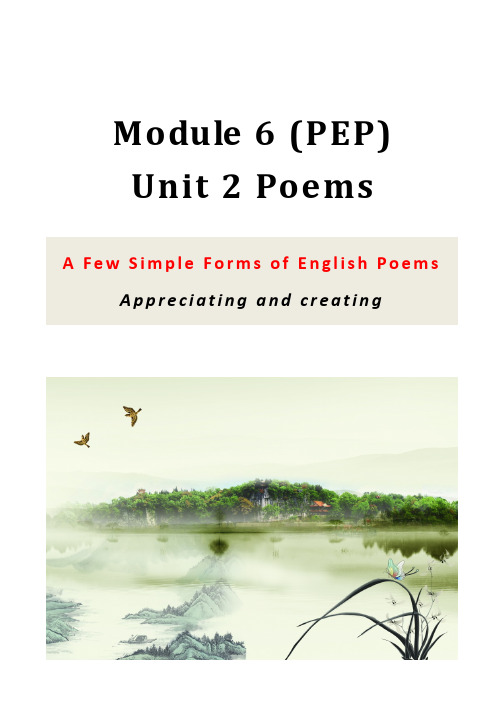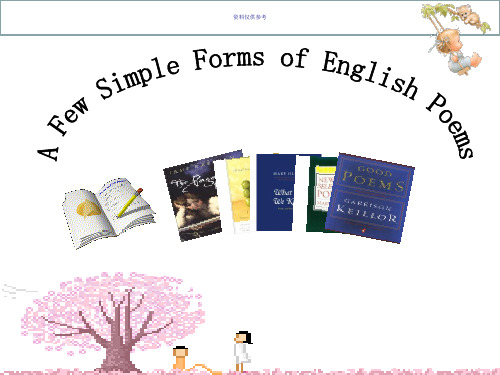a few simple forms of english poems
- 格式:ppt
- 大小:41.50 KB
- 文档页数:7

Module 6 (PEP)Unit 2 PoemsA Fe w S i m p l e F o r m s o f E n g l i s h P o e m sA p p r e c i a t i n g a n d c r e a t i n gTeaching DesignBasic InformationTopic Module 6 Unit 2 Poems—A Few Simple Forms of English PoemsSubject English Grade Senior Two Duration 1 period Teacher Mingjun Zhao赵明君School Huixian No. 1 Senior High SchoolGuiding Ideology and Theoretical BasisI. Poetry involves almost every aspect of the language. A good poem is characterized by the best choice of words. It may contain vivid imagery, or clear rhythm and rhyme, or ingenious combination of sound and sense, or imaginative and enlightening statements. As Francis Bacon points out in his Of Studies, “poems (make men) witty”. Reading poems can help deepen our sense of life, enrich our feelings and refine our minds, and it can also offer spiritual pleasure.II. As is required by English Curriculum Standards for Senior High Schools (2017 edition), students need to be exposed to and learn different types of texts, grasp structures, stylistic features and means of expressions of different texts, which helps them to deepen their understanding of the texts and express and communicate using different types of texts.III. “Poetry” is a required text type in optional compulsory courses. As for the course content, it is required by the English Curriculum Standards that students should, through learning activities, understand and appreciate some excellent English literary works, develop positive values and attitudes towards life from the beauty of the works in connotation, get aesthetic experience by observing and appreciating aesthetic elements (form and connotation) in the texts, and acquire appreciation perception of language and things.Analysis of Teaching Background and ContentThematic context Man and society – PoemsText type ExpositionAnalysis of the Teaching Material [What]The text, A Few Simple Forms of English Poems, is the main text of Unit 2 Poems in New Senior English for China Student’s Book 6 (PEP). It introduces five types of English poems (nursery rhyme, list poem, cinquain, haiku, and Tang poem), and presents corresponding examples. The poems given in the text, which show distinctive features of the five types of poems, are concise in language, popular and easy to understand. Besides, their topics are closely related to students’ life.Nursery rhyme has a strong rhythm and it rhymes. List poem is characterized by repeated phrases, clear structure and strong emotions. Besides, it is easy to create. Cinquain, as its name implies, consists of five lines. It has a regular pattern in the number of words in each line and their parts of speech. Moreover, with a clear and concise structure, it can express strong emotions with only 11 words. Haiku is a form of classic short poem introduced from Japan, consisting of 3 lines, 17 syllables. It can create a vivid picture with the minimum of words. Tang poem, the treasure of Chinese culture, though not a traditional form of English poem, is also popular with English-speaking countries.[Why]English poetry is a world with rich social content, language arts, and social connotation. Poems are valuable learning materials with diverse types. By introducing different types of poems, the author guides the students to pay attention to the purpose of writing poems, learnabout the “musical”, “visual” and “imagery” beauty of poems. Through reading, students will learn about features of the five types of poems, appreciate the “beauty” of poems, get aesthetic experience, and develop aesthetic judgment, so as to learn to create simple English poems. [How]The text is an expository essay, which introduces five simple forms of English poems. It has distinct layers and clear points. The whole passage develops revolving around the question “Why do poets write poems”, and introduces the reasons for writing poems. The first sentence in each paragraph is the topic sentence, followed by simple and clear language to introduce features of the five forms of English poems. One or two poems are also given as examples.Analysis of the Students [Students’ profile]Senior Two students have good English learning basis. They have a certain amount of vocabulary and some reading skills, and have developed some reading strategies.[What they have]The survey before class reveals that the students in my class have certain ability of Chinese poem appreciation, and have some perceptual knowledge of metrical patterns of Chinese poetry, which lay good foundation for learning English poems. Some students have been exposed to some simple English nursery rhymes, and know some translated or original lines of famous English poems. Besides, some students are interested in English poems. In the list of aspects of English poetry they’d like to know are: to learn the background and purpose of poem writing; to learn about artistic conception of poems; to learn some simple poems which are easy to remember; differences between English poems and Chinese poems in rules of rhyming; how to adapt poems into rap music; how to present poems via animation; to learn some inspiring poems, etc.[What they lack]The students have never appreciated English poems and thus lack experience in doing so and don’t know from what aspects to appreciate English poems. Besides, the students have never created any English poems. Therefore, while doing so, the words they choose may be limited and may not convey their true feelings. Moreover, the majority of the students can’t count syllables in a word, which makes it difficult to appreciate the metric patterns of English poems.Teaching ObjectivesBy the end of the class, the students will be able to:nguage proficiency:1) understand the meaning of some key words, such as nursery rhyme, list poem, cinquain, haiku, Tang poem, rhythm, rhyme, emotion, etc.2) know about five simple forms of English poems2. Cultural awareness:1) appreciate five English poems in the text from five aspects2) respect and understand diversity of culture; further boost the students’ cultural confidence; raise their awareness of spreading splendid Chinese culture3. Thinking quality:develop their creative thinking ability by creating a cinquain4. Learning ability:enhance their interest in English learningFocal and Difficult Teaching PointsFocal teaching points:To enable the students to:1. appreciate the beauty of poems through reading2. appreciate the beauty of emotions expressed in the poems3. create cinquain poems on their ownDifficult teaching points:1.Students’ lack of exposure to English poems;2.Students’ lack of skills of reading aloud;3.Boosting the students’ confidence in creation and motivating them to create their own cinquain poems.Teaching MethodActivity-based teaching methodTeaching Activity DesignActivities Purpose of design TimeStep 1: Lead-inActivity 1 Enjoy a video of a Chinese poem – Written on the Wall of West Forest TempleActivity 2 Read the English version of Written on the Wall of West Forest Temple togetherTip 1: Pause between sense groups Activate the students’ known information about Chinese poems and arouse their interest in the English version of the poem. Appreciate the English version of the poem by reading aloud; learn the tipof pausing between sense groups.3’Step 2: Poem Appreciation Poem H Tang PoemActivity 3 Read Poem HQ: What emotions are expressed in the poem?Tip 2: Read with emotionsPoem A – Nursery RhymeActivity 4 Sing a songActivity 5 Chant togetherPresent the rhythmic pattern of stressed syllables alternating with unstressed syllables, and make the students experience the beauty of rhythm and rhyme in chanting.Tip 3: Read with rhythm Appreciate the poem through reading aloud and read with emotions.Make the students feel the strong rhythm by learning to sing the song and clappingto the beat.By asking the Ss to clap and with the help of slides, helpthe students get to experience the meaning of “rhythm”.25’Activity 6 Discover main featuresQ1: Why is “broke” used instead of “broken”?Q2: Can you find some repeated phrases?Poem C – List PoemActivity 7 Find the repeated wordQ: Can you find the repeated word?Activity 8 Finish a list poemAsk the Students to finish a list poem to the person they’d like to say thank you to by filling the blanks.Poem F HaikuActivity 9: Listen and read aloudActivity 10: Describe pictures formed in mindQ1:What picture can you see in your mind?Show the moving picture of a fallen cherry blossom on the ground slowly going back to the branch and turning into a butterfly.Summarize the beauty in Haiku: imagePoem E-CinquainActivity 11 Find the beauty in shapeQ: What shape do they (Poem D & E) look like?Ask Ss to observe and find the features of cinquain, e.g. line numbers, the number of words in each line, parts of speech of the words, etc.Activity 12 Read for emotionRead Poem E together.Q1: Does the writer like or dislike summer?Q2: From which words do you know?Activity 13 Think for dictionQ: Can “salty” be changed into “hot”? Why or why not? Discover the feature of “rhyme”.Discover the feature of repetition.Eliminate the students’ fear of creating English poems. Lower the difficulty of creating a list poem with a blank-filling exercise. Cultivate the students’ awareness of being grateful.By asking Ss to describe the picture in their minds, make them understand the exact meaning of the poem. The animation can make them appreciate the beauty of English poems visually.Find the beauty in shape.Cinquain is the focal point of appreciation, because good appreciation of it can lay a solid foundation for the later output stage, i.e. Poem Creation.Activity 14 Analyze the structure of a cinquain.Q: How many lines are there? How many words are there in each line? What are their parts of speech? How many words are there in total?Summarize that the beauty of cinquain poems lies in shape, emotion and diction. By asking a series of questions, guide the students to appreciate the beauty of cinquain: shape, emotion, and diction, as well as the “hatred” of the writer for summer.Analyzing the structure of cinquains can help the students to realize that it’s easy to create a cinquain.Step 3 Poem Creation Activity 15 Create a cinquain together.Create a cinquain on “Spring” with all the students together by offering them some adjectives.Activity 16: Create a cinquain on their ownProvide guidance:1.show the structure and template of a cinquain;2.provide topics to choose from. Make the students realizethat writing a poem can beso easy, so as to boost their confidence and pave theway for the later cinquain creation.8’SummaryActivity 17 SummarySummarize what have been learned: five forms of English poems and five forms of beauty.Play a video to show the students what they can do to learn both Chinese and English well to spread the splendid Chinese culture to the world.Encourage Ss to learn both English and Chinese well to make contributions to the “going out” of Chineseculture.3’HomeworkRecord a video to introduce the English version of your favorite Tang poem in a creative way. To record a video, students will need to practice the English version of their favorite Tang poems again and again, so that they will learn to read them by heart and recite them.Hopefully they can think of more creative ways to develop their creative thinking abilities.1’Blackboard Design。

高中英语人教版选修六-U n i t2-精读课文逐句翻译(总3页)--本页仅作为文档封面,使用时请直接删除即可----内页可以根据需求调整合适字体及大小--选修六Unit 2 A FEW SIMPLE FORMS OF ENGLISH POEMS简体英文诗There are various reasons why people write poetry. 人们写诗有着各种各样的理由。
Some poems tell a story or describe something in a way that will give the reader a strong impression. 有些诗是为了叙事,或者说是描述某件事并给读者以强烈的印象。
Others try to convey certain emotions. 而有些诗则是为了传达某种感情。
Poets use many different forms of poetry to express themselves. 诗人用许多不同风格的诗来表达自己的情感。
In this text, however, we will look at a few of the simpler forms. 本文只谈了几种格式比较简单的诗。
Some of the first poetry a young child learns in English is nursery rhymes. 孩子们最早学习的英文诗是童谣。
These rhymes like the one on the right (A) are still a common type of children's poetry. 像右边的这首童谣(A)至今仍然是常见的。
The language is concrete but imaginative, and they delight small children because they rhyme, have strong rhythm and a lot of repetition. 童谣的语言具体但富有想象力,这使得小孩子们快乐,因为它们押韵,节奏感强,并较多重复。


教案(展鑫磊) A Few Simple Forms of English Poems一、教学目标1. 让学生了解和掌握英语诗歌的基本形式,包括押韵诗、自由诗、十四行诗等。
2. 通过诗歌欣赏和创作,提高学生对英语语言的感知和运用能力。
3. 培养学生的审美情趣,激发他们对英语诗歌的热爱。
二、教学内容1. 押韵诗(Rhyming Poem):介绍押韵诗的基本结构,让学生欣赏和分析押韵诗的例子,自己创作一首押韵诗。
2. 自由诗(Free Verse):介绍自由诗的特点,让学生欣赏和分析自由诗的例子,自己创作一首自由诗。
3. 十四行诗(Sonnet):介绍十四行诗的结构和韵律,让学生欣赏和分析十四行诗的例子,自己创作一首十四行诗。
4. 俳句(Hku):介绍俳句的基本结构和主题,让学生欣赏和分析俳句的例子,自己创作一首俳句。
5. 民谣(Ballad):介绍民谣的基本特点,让学生欣赏和分析民谣的例子,自己创作一首民谣。
三、教学方法1. 讲授法:讲解诗歌的基本形式和特点,引导学生欣赏和分析诗歌。
2. 实践法:让学生通过创作诗歌,提高英语语言运用能力。
3. 互动法:组织学生进行诗歌朗诵、分享和讨论,培养他们的合作和交流能力。
四、教学步骤1. 引入:通过提问方式引导学生思考诗歌的形式和特点。
2. 讲解:讲解诗歌的基本形式,包括押韵诗、自由诗、十四行诗等。
3. 欣赏:让学生欣赏和分析不同形式的诗歌例子。
4. 创作:让学生自己创作一首诗歌,可以选取其中一种形式。
5. 分享:组织学生分享自己的创作,并进行互动交流。
五、教学评估1. 观察学生在课堂上的参与程度,了解他们对诗歌形式的掌握情况。
2. 评估学生的诗歌创作,关注他们的语言表达和创造力。
3. 收集学生的反馈意见,了解他们对诗歌教学的看法和建议。
六、教学资源1. 诗歌文本:收集不同形式的英语诗歌,用于教学欣赏和分析。
2. 诗歌创作指导:提供诗歌创作的模板和参考资料,帮助学生进行创作。


UNIT 5 POEMS单元目标主题学习目标通过本单元学习了解诗歌的不同形式和内容, 了解韵律和节奏, 培养对诗歌的兴趣。
语言能力目标核心单词drama, sorow, literary, rhyme, folk, diamond, recite, amateur, mod,format, respective, delicate, comprehension, shelf, core, blank,civilian,sympathy, version, inocent, era, corespond, sow, sed, deadline,contest, polish, string, complicated, variation, racial, prejudice 重点词块nurseryrhyme, bemadeupof单元语法复习定语从句写作能力根据本单元所学知识能够写一篇语言简洁、结构清晰的与诗歌有关的应用文。
背景导学Anyone can write a baby poem, and everyone enjoys reading it, the young and the old. Baby shower(送礼聚会) poems can have rhythm and rhyme, but they certainly don’t have to. Poems can be either long or short, but short poems are probably best for your typical baby shower needs. You can add a little humor as well!The people who are most often touched by baby shower poems are those who have had children themselves. Sweet poems can remind them of the time when their little ones were still young. No one will appreciate them more than the family members themselves. If you are a creative writer or have a special talent for putting words together in a special way, then you should try writing your own baby shower poems. This would make a great gift as well.If you decide to write your own baby poems, even common things can inspire you. Inspiration can be found anywhere. Look back on your own memories from the past. What was special about your childhood? What special objects have you treasured overthe years? What words of wisdom (智慧) could you pass on to the next generation? Look around the house and imagine a baby being there. What do you see, hear, or feel? Let those thoughts be the sources of your best baby poems.When writing a baby poem, you do not have to write like Shakespeare, and you just have to be sincere. When the baby grows up, you can think of how special they will feel knowing the words are just for them.If you are not the creative type-don’t worry! There are lots of places online where you can look for poems saying just the things you want to say. Poems have been written on all subjects throughout the ages, and baby shower poems are no exception. A quick search online doesn’t have to take any time at all.1.In the author’s opinion, baby shower poems .A.all have a little humor in themB.are not suitable for adults to enjoyC.don’t have to have rhythm or rhymeD.must be short enough to meet babies’ needs答案: C2.What does Paragraph 3 mainly talk about?A.Advice from famous poets on writing poems.B.Words that can be used in baby poems.C.Different ways of writing baby poems.D.Inspiration for writing baby poems.答案: D3.According to Paragraph 4, a baby poem should sound .A.encouragingB.sincereC.beautifulD.interesting答案: BSection Ⅰ Reading and Thinking自主学习·激发潜能Ⅰ. 课文翻译教材原文A FEW SIMPLE FORMS OF ENGLISH POEMSThere are various reasons why people compose poetry. Some poems tell a story or describe a certain image in the reader’s mind. Others try to convey certain feelings such as joy and sorrow. The distinctive characteristics of poetry often include economical use of words, descriptive and vivid language, integrated imagery, literary devices such as similes and metaphors, and arrangement of words, lines, rhymes, and rhythm. Poets use many different forms of poetry to express themselves. Now we will look at a few of the simpler forms.Some of the first poems a young child learns in English are nursery rhymes. They are usually the traditional poems or folk songs. The language of these rhymes, like Poem A, is to the point but has a storyline. Many children enjoy nursery rhymes because they rhyme, have a strong rhythm, and often repeat the same words. The poems may not make sense and even seem contradictory, but they are easy to learn and recite. By playing with the words in nursery rhymes, children learn about language. AHush, little baby, don’t say a word,Papa’s gonna buy you a mockingbird.If that mockingbird won’t sing,教材译文英文诗歌的几种简单形式人们写诗的原因多种多样。
a few simple forms of english poems. 英文诗歌的几种简单形式
以下是几种常见的英文诗歌形式:
1. 五行诗:五行诗也称为五句诗,是一种常见的诗歌形式,通常由五行五个句子组成。
第一行通常为主题句,后面四行则是对主题句的展开和深化。
2. 十四行诗:十四行诗是一种欧洲传统的诗歌形式,通常由十四行组成,每行通常有十个左右的单词。
十四行诗的韵律和格式都有一定的要求,通常是前八行叙述或者描述,后六行则进行总结或者升华。
3. 自由诗:自由诗是一种不受传统诗歌形式的约束的诗歌形式,通常没有固定的韵律和格式,强调个性和自由。
自由诗的语言通常比较口语化,表达直接,情感真挚。
4. 素体诗:素体诗是一种每行五个音步的诗歌形式,通常是抑扬格或者抑扬格
合韵。
素体诗的韵律感强,语言优美,是英文诗歌中的一种重要形式。
5. 挽歌:挽歌是一种哀悼或者纪念已故者的诗歌形式,通常比较庄重、肃穆。
挽歌的语言优美,情感真挚,常常用一些象征性的形象来表达哀思和纪念之情。
这些是英文诗歌中的几种常见形式,每种形式都有其独特的特点和要求,对于英文诗歌的创作和理解都有一定的帮助。
参考译文A few simple forms of English poems英语诗歌的几种简单形式人们写诗有着各种各样的理由。
有些诗是为了叙事,或者说是描述某件事,并给读者以强烈的印象。
而有些诗则是为了传达某种感情。
诗人用许多不同格式的诗来表达自己的情感。
本文只谈了几种格式比较简单的诗。
最早用英文写的诗是童谣。
孩子们很小就学习童谣。
像下边的这首童谣(A)至今仍然是常见的。
这些童谣能使俏皮孩子们快乐,因为它们节奏感强并且押韵,而且重复多遍。
这样就容易学,也容易背。
通过童谣中的文字游戏,教孩子们学习语言。
(A)小宝宝,别吵吵,爸爸给你买个小哩鸟。
小哩鸟,不会唱,爸爸给你买个钻石戒。
钻石戒,变成铜爸爸给你买个小镜子。
小镜子,打破了,爸爸给你买个小山羊。
小山羊,跑掉了。
爸爸今天再去买一只。
像(B)和(C)这样列举事物的清单诗是诗歌中最简单的一种,学生可以自己动手写。
清单诗可以重复一些短语和韵脚(如B),但有一些也不是这样(如C)。
(B)我看到鱼塘在燃烧我看到鱼塘在燃烧,我看到房子向地主哈腰,我看到人高一丈八,我看到茅屋在天郊,我看到气球用铝做。
我看到棺材把死人抛。
我看到两只麻雀在赛跑,我看到两匹马儿绣花包。
我看到姑娘像只猫,我看到小猫戴花帽。
我看到有人在一旁瞄,虽奇怪,但也把实情报。
(C)我们的第一场球赛我们本来会得冠军……如果杰克踢进了那个球,如果我们还有几分钟,如果我们训练得更严格,如果本把球传给了乔,如果有大批球迷助威,如果我死死盯住球,如果我们头晚不熬夜,如果我们没有太大意,如果我们没有精疲力竭,我们本来会得冠军……如果我们再干得好一些!另外,一种学生容易写的简体诗是由五行组成的,叫做五行诗。
用五行诗,学生可以用少量的词语传递一幅动人的画面。
请看下面的(D)和(E)两个例子。
(D)兄弟爱美,又爱运动爱闹,爱叫,又爱笑是我的朋友也是我的敌人(E)夏天困乏,刺激干涸,枯萎,恐怖周而复始永无止境俳句诗(Haiku)是一种日本诗,由17个音节组成。